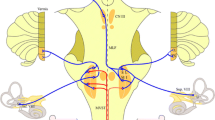Abstract
Cervical vestibular-evoked myogenic potentials (cVEMPs) are accepted to demonstrate the vestibulo-collic reflex. However, the brainstem pathway is still not fully understood. The aim of the study was to evaluate the contribution of cVEMPs to detection of brainstem involvement in multiple sclerosis (MS). Thirty patients fulfilling the criteria for definite MS were included in the study. All were newly diagnosed cases, admitted due to an attack with active lesions on MRI. Thirty-one age- and sex-matched healthy controls constituted the control group. The latencies of peaks p13 and n23 and peak-to-peak amplitude of p13–n23 were measured. Brainstem lesions on MRI were present in 13 of the patients (43.4%). Comparison of the overall results recorded from patients with the healthy controls did not reveal a statistically significant difference in any of the parameters studied (p > 0.05). A significant inter-side difference was not also present between groups (p > 0.05). When p13 and n23 latencies exceeding 2.5 standard deviations (SD) were taken into consideration, it was seen that there were seven patients (23.3%) with prolonged latencies mainly involving the p13 peak. Five of them had brainstem signs on examination and had brainstem lesions on MRI. In the other eight patients with abnormal MRI, normal results were recorded indicating that in only 38% of patients with brainstem lesions, cVEMPs were altered. Absence of a correlation between cVEMPs and brainstem clinical or MRI lesions defies their role in identifying lower brainstem involvement.




Similar content being viewed by others
References
Colebatch JG, Halmagyi GM (1992) Vestibular evoked potentials in human neck muscles before and after unilateral vestibular deafferentation. Neurology 42(8):1635–1636. https://doi.org/10.1212/WNL.42.8.1635
Colebatch JG, Halmagyi GM, Skuse NF (1994) Myogenic potentials generated by a click-evoked vestibulocollic reflex. J Neurol Neurosurg Psychiatry 57(2):190–197. https://doi.org/10.1136/jnnp.57.2.190
Welgampola MS, Colebatch JG (2005) Characteristics and clinical applications of vestibular evoked myogenic potentials. Neurology 64(10):1682–1688. https://doi.org/10.1212/01.WNL.0000161876.20552.AA
Rauch SD (2006) Vestibular evoked myogenic potentials. Curr Opin Otolaryngol Head Neck Surg 14(5):299–304. https://doi.org/10.1097/01.moo.0000244185.65022.01
Honaker JA, Samy RN (2007) Vestibular evoked myogenic potentials. Curr Opin Otolaryngol Head Neck Surg 15(5):330–334. https://doi.org/10.1097/MOO.0b013e3282ef7d0d
Welgampola MS (2008) Evoked potential testing in neuro-otology. Curr Opin Neurol 21(1):29–35. https://doi.org/10.1097/WCO.0b013e3282f39184
Rosengren SM, Welgampola MS, Colebatch JG (2010) Vestibular evoked myogenic potentials: past, present and future. Clin Neurophysiol 121(5):636–651. https://doi.org/10.1016/j.clinph.2009.10.016
Eleftheriadou A, Koudounarakis E (2011) Vestibular evoked myogenic potentials eliciting: an overview. Eur Arch Otorhinolaryngol 268(3):331–339. https://doi.org/10.1007/s00405-010-1408-7
Hong SM, Yeo SG, Kim SW, Cha CI (2008) The results of vestibular evoked myogenic potentials, with consideration of age-related changes, in vestibular neuritis, benign paroxysmal positional vertigo, and Meniere’s disease. Acta Otolaryngol 128(8):861–865. https://doi.org/10.1080/00016480701784981
Deftereos SN, Panagopoulos G, Eleftheriadou A, Korres S, Georgonikou D, Kandiloros D, Karageorgiou CE (2008) Using vestibular evoked myogenic potentials to localize brainstem lesions. A preliminary report. B-ENT 4(4):215–219
Itoh A, Kim YS, Yoshioka K, Kanaya M, Enomoto H, Hiraiwa F, Mizuno M (2001) Clinical study of vestibular-evoked myogenic potentials and auditory brainstem responses in patients with brainstem lesions. Acta Otolaryngol Suppl 545:116–119
Heide G, Luft B, Franke J, Schmidt P, Witte OW, Axer H (2010) Brainstem representation of vestibular evoked myogenic potentials. Clin Neurophysiol 121(7):1102–1108. https://doi.org/10.1016/j.clinph.2010.02.007
Polman CH, Reingold SC, Banwell B, Clanet M, Cohen JA, Filippi M, Fujihara K, Havrdova E, Hutchinson M, Kappos L, Lublin FD, Montalban X, O'Connor P, Sandberg-Wollheim M, Thompson AJ, Waubant E, Weinshenker B, Wolinsky JS (2011) Diagnostic criteria for multiple sclerosis: 2010 revisions to the McDonald criteria. Ann Neurol 69(2):292–302. https://doi.org/10.1002/ana.22366
Sartucci F, Logi F (2002) Vestibular-evoked myogenic potentials: a method to assess vestibulo-spinal conduction in multiple sclerosis patients. Brain Res Bull 59(1):59–63. https://doi.org/10.1016/S0361-9230(02)00842-0
Versino M, Colnaghia S, Calliecoa R, Bergamaschib R, Romanib A, Cosia V (2002) Vestibular evoked myogenic potentials in multiple sclerosis patients. Clin Neurophysiol 113(9):1464–1469. https://doi.org/10.1016/S1388-2457(02)00155-4
Bandini F, Beronio A, Ghiglione E, Solaro C, Parodi RC, Mazzella L (2004) The diagnostic value of vestibular evoked myogenic potentials in multiple sclerosis. J Neurol 251(5):617–621. https://doi.org/10.1007/s00415-004-0378-3
Alpini D, Pugnetti L, Caputo D, Cornelio F, Capobianco S, Cesarani A (2004) Vestibular evoked myogenic potentials in multiple sclerosis: clinical and imaging correlations. Mult Scler 10(3):316–322. https://doi.org/10.1191/1352458504ms1041oa
Patkó T, Simó M, Arányi Z (2007) Vestibular click-evoked myogenic potentials: sensitivity and factors determining abnormality in patients with multiple sclerosis. Mult Scler 13(2):193–198. https://doi.org/10.1177/1352458506070940
Eleftheriadou A, Deftereos SN, Zarikas V, Panagopoulos G, Sfetsos S, Karageorgiou CL, Ferekidou E, Kandiloros D, Korres S (2009) The diagnostic value of earlier and later components of vestibular evoked myogenic potentials (VEMP) in multiple sclerosis. J Vest Res 19:59–66
Gazioğlu S, Boz C (2012) Ocular and cervical vestibular evoked myogenic potentials in multiple sclerosis patients. Clin Neurophysiol 123(9):1872–1879. https://doi.org/10.1016/j.clinph.2012.01.022
Ivankovic A, Madaric VN, Starcevic K, Skoric MK, Gabelic T, Adamec I, Habek M (2013) Auditory evoked potentials and vestibular evoked myogenic potentials in evaluation of brainstem lesions in multiple sclerosis. J Neurol Sci 328(1-2):24–27. https://doi.org/10.1016/j.jns.2013.02.005
Garcia VE, Carratala IL, Alborch MO, Algarra JM (2013) Vestibular evoked myogenic potential findings in multiple sclerosis. Acta Otorrinolaringol Esp 64(5):352–358. https://doi.org/10.1016/j.otoeng.2013.10.009
Güven H, Bayır Ö, Aytaç E, Özdek A, Çomoğlu SS, Korkmaz H (2014) Vestibular-evoked myogenic potentials, clinical evaluation and imaging findings in multiple sclerosis. Neurol Sci 35(2):221–226. https://doi.org/10.1007/s10072-013-1483-9
Crnosija L, Skoric MK, Gabelic T, Adamec I, Brinar V, Habek M (2015) Correlation of the VEMP score, ambulation and upper extremity function in clinically isolated syndrome. J Neurol Sci 359(1-2):197–201. https://doi.org/10.1016/j.jns.2015.10.049
Gabelic T, Skoric MK, Adamec I, Barun B, Zadro I, Habek M (2015) The vestibular evoked myogenic potentials (VEMP) score: a promising tool for evaluation of brainstem involvement in multiple sclerosis. Eur J Neurol 22(2):261–269. https://doi.org/10.1111/ene.12557
Author information
Authors and Affiliations
Corresponding author
Ethics declarations
Approval from the ethics committee of Ege University Medical School was obtained, and all the patients gave their written informed consent for the procedure.
Rights and permissions
About this article
Cite this article
Kavasoğlu, G., Gökçay, F., Yüceyar, N. et al. Cervical vestibular-evoked myogenic potentials in patients with multiple sclerosis: sensitive in detecting brainstem involvement?. Neurol Sci 39, 365–371 (2018). https://doi.org/10.1007/s10072-017-3215-z
Received:
Accepted:
Published:
Issue Date:
DOI: https://doi.org/10.1007/s10072-017-3215-z



